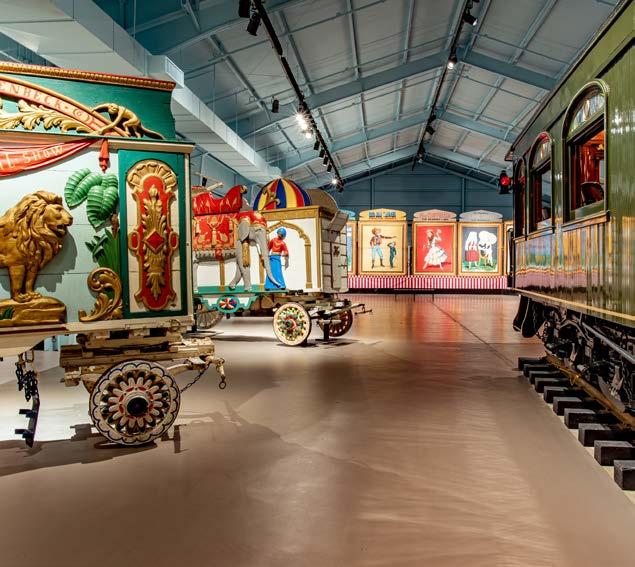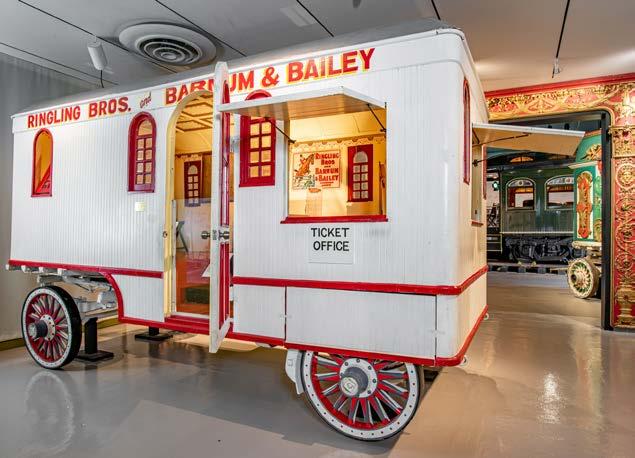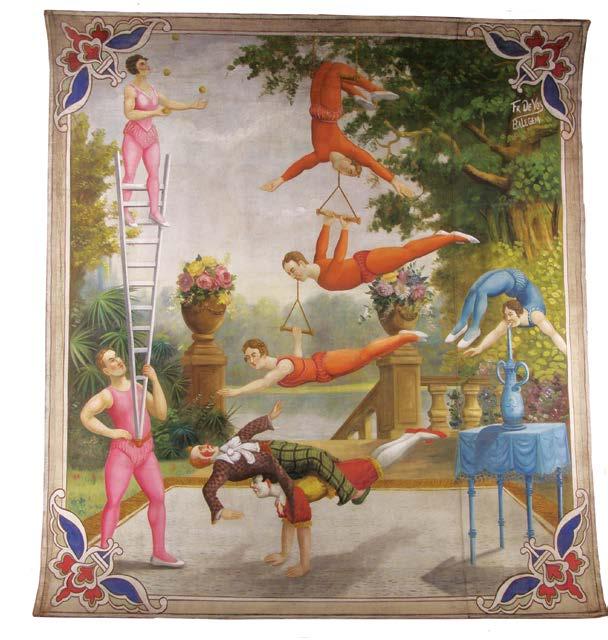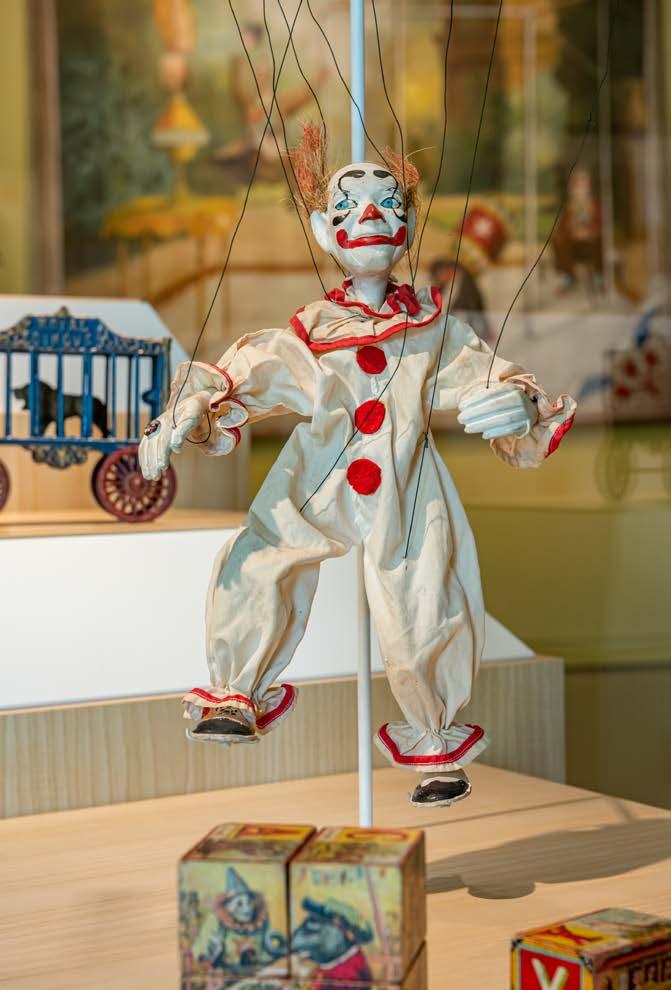
5 minute read
WELCOME BACK to the HISTORIC CIRCUS GALLERIES
by Jennifer Lemmer Posey
Tibbals Curator of Circus
When the idea for a Circus Museum was put forth by The Ringling’s first Director, Everett “Chick” Austin, he promised that “the circus showplace will evoke the circus spirit…big top performers will regard it as a unique, authentic center of circus art.” Austin quickly began growing the collections of historic circus wagons, original costumes, props, posters, and prints. Although it was named The Museum of the American Circus when it first opened in 1948, the collections immediately reflected the international reach of the circus arts.
To house the growing collection, Austin repurposed a historic structure that had once served as the garage for John and Mable Ringling’s automobiles. To those three bays he added a semi-circular Rotunda to evoke the small one ring tents of the earliest American circuses. The galleries were installed with a flamboyant mix of circus posters, costumes, and wagons placed in spaces decorated with gilded sconces and elaborate entryways purchased by John Ringling from the estates of such Gilded Age titans as the Astor family.
Over time, new spaces were added to the building, to show more of the collections and, eventually, enclosing an exterior wagon yard to protect the one-of-a-kind collection objects from the elements. With the projects to build and later extend the Circus Museum’s Tibbals Learning Center, attention was drawn away from the Historic Galleries, aside from the extraordinary installation in 2008 of The Wisconsin Pullman car.

The Wagon Room, featuring The Wisconsin Pullman car.
Recognizing the charm of the historic building as well as the need to update the galleries, in 2019 The Ringling embarked upon a project to reinstall the Historic Circus Museum galleries. The project had a number of goals. First and foremost is to assure the care and presentation of the Circus collection. In the Wagon Room, refinished galleries and a new lighting plan allow us to once again showcase the biggest objects in The Ringling collections: our beautiful parade wagons and the magnificent Wisconsin.
The center galleries continue to honor the history of the Ringling family circus, welcoming visitors with the White Ticket Wagon, originally built in 1911. Once tucked into the Backyard gallery with the baggage wagons, this beautiful example of circus craftsmanship is now visible from the moment visitors enter the building. Filling up the small center gallery, the wagon is juxtaposed with the ornate architectural arch and the Wisconsin Railroad Car. Creating this visual relationship helps highlight the beautiful craftsmanship, which is mirrored in the construction of the 1904 Wisconsin Car.

White Ticket Wagon
The Ringling Family galleries feature objects that relate directly to the family and the early years of the circus—from saddles embossed with the names of the brothers to the 1882 herald for the Yankee Robinson and Ringling Bros. Great Double Shows, the only season that the Ringling name took second billing. As curatorial research expands through increased access to historic newspapers and other materials, the inclusion of more objects in these spaces will allow flexibility in sharing the stories of John Ringling and his brothers.
The most significant change in the galleries is the newly installed Rotunda, featuring “Curiosities of the Collection.” The gallery provides a space for rotating the rich diversity of objects that are part of the collection through thematic displays organized around history and cultural trends. The current installation celebrates the breadth of the Circus collection. Of the forty-three pieces shown in the Rotunda, only five have been on display in the museum in the last two decades or more.

De Vos Banner
Two banners painted by Frans De Vos for the front of a small Belgian circus in the early 1900s are centerpieces of the space. In 2005, these two banners along with two others by the artist were donated to the museum by Howard and Janice Tibbals. A special piece of the story of the De Vos banners was that their restoration in the ARTEX Conservation Laboratory was overseen by Barbara A. Ramsay before she was hired as The Ringling’s Chief Conservator in 2014. After years of restoration work, the four banners were proudly displayed in the Searing Wing later that year. Just as they once welcomed audiences to a circus, they now draw museum visitors into the galleries. These beautiful paintings depict a variety of acrobatic feats set against pastoral scenes, and remind us that all forms of the arts are integrated into the world of the circus.
The artistry of the De Vos banners is in wonderful contrast with other objects in the gallery, including a simple steel bucket lettered with the name “Concello.” This modest object is a representation of the logistical genius of the tented circus. Each performer received two buckets of water on the circus lot for cleaning. This particular bucket belonged to Arthur Concello who was a famous trapeze artist before becoming a legendary General Manager for the Ringling show. His knowledge and creativity left a mark on many aspects of the circus industry and he was part of the community who made their home here in Sarasota. Learn more about Concello’s bucket and some related objects that illustrate the life of Charlotte Shive a performer with Ringling Bros. and Barnum & Bailey in the early 20th century.

Marionette of Bill Ballantine by renowned puppet maker, Bill Baird.
Another circus performer who made his home in Sarasota is represented in the Rotunda by a whimsical marionette. Writer and performer Bill Ballantine toured as a clown with the Ringling show in the late 1940s and would return to become Dean of Ringling Bros. and Barnum & Bailey Clown College from 1969 to 1977. Ballantine’s friend Bill Baird, a renowned puppet maker known for performing “The Lonely Goatherd” puppet show in The Sound of Music, created the puppet of Ballantine in his clown costume.
The gallery also includes twelve prints, ranging in date across the 18th and 19th centuries, which were early additions to the Circus collections. The Engravings and other widely distributed forms of popular print frequently included subjects from the circus and allied arts. As such they represent both unique objects from the artistic tradition of print and wonderful documents of the ubiquity of the circus arts in western culture. Such prints were among the earliest objects added to the Circus collection under the tenure of Everett “Chick” Austin and represent a fascination with the circus arts that predate the advent of the modern circus as we know it. Viewed with the knowledge of the 21st century, many of these prints represent individuals and events which are now recognized as foundational to circus history.
In showcasing a selection of the unseen treasures of the Circus collection, the Historic Circus Galleries encourage our guests to explore some of the unique stories of people and events that have shaped circus history.





